Endangered Sea Turtle II
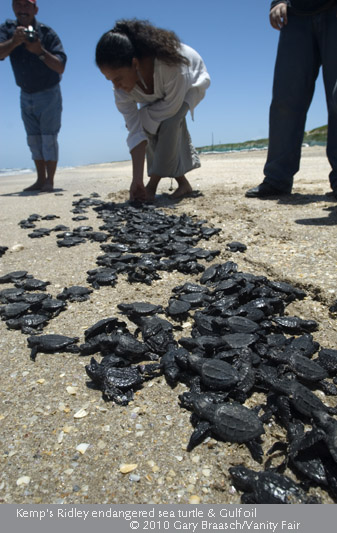
Incubated hatchlings (rescued from nests and saved by keeping them warm for a few hours to a few days) being released to enter the Gulf of Mexico, watched over by Lizbet Gongora Berlin of CONANP, the Mexican National nature protection agency. Kemp's Ridley sea turtle main nesting ground and hatching area, Playa Rancho Nuevo, a Mexican national reserve, where Dr. Gloria Tavera and staff, plus staff from Gladys Porter Zoo in Brownsville TX and students protect and manage eggs laid by the most endangered sea turtle.
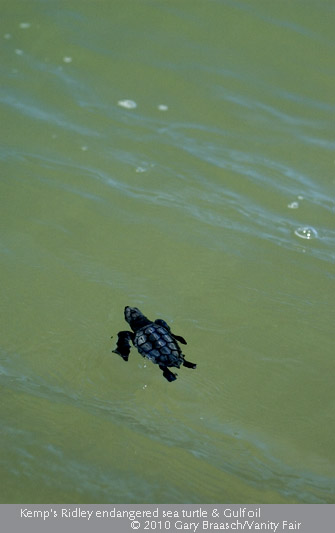
Kemp's Ridley sea turtle heads into the Gulf of Mexico from main nesting ground and hatching area, Playa Rancho Nuevo Sanctuary. Only one hatchling per thousand is estimated to make it to maturity. The baby turtles swim directly out into the Gulf to reach sargassum sea weed habitat -- which is also the area with about 4000 oil and gas rigs, and which was polluted by the BP oil spill. More than 500 young Kemp's ridleys from previous year's hatchings were caught up in the oil near the Deepwater Horizon well and along shorelines affected by the spill.
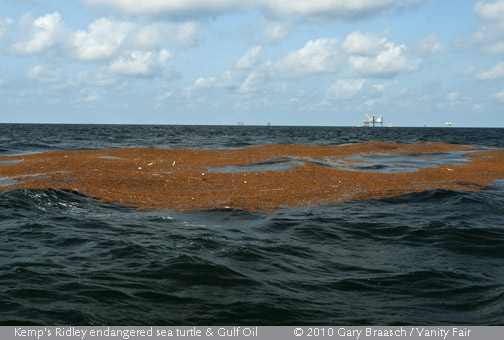
Sagassum seaweed floating in great mats along current lines in the Gulf of Mexico is rich habitat for fish, shrimp, and sea turtles, including immature Kemp's Ridley sea turtles. It is already heavily impacted by waste plastic and pollution from petroleum exploration and drilling -- oil from the BP oil disaster collected there. Thus the seaweed was the prime place for turtles to be caught up in the oil.
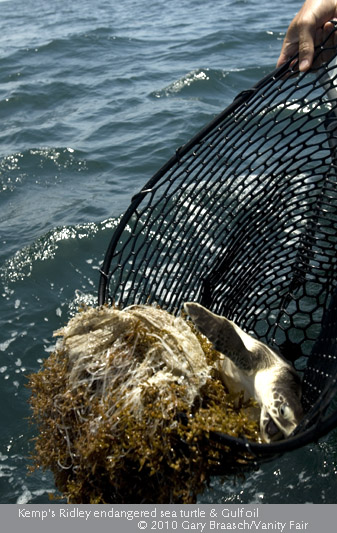
During a turtle search mission by the Louisiana State Dept of Wildlife & Fisheries about 30 miles south of the Delta, a young Kemp's ridley is netted out of the sargassum seaweed. It was oiled and had its rear flipper caught in woven plastic feed or rice bag. Thus this turtle was caught by both the raw crude oil and one of the things we make from oil and carelessly discard. The Kemp's ridley, Lepidochelys kempii, is the most endangered of the sea turtles of the Gulf. Its juvenile habitat is centered in the oil spill area.
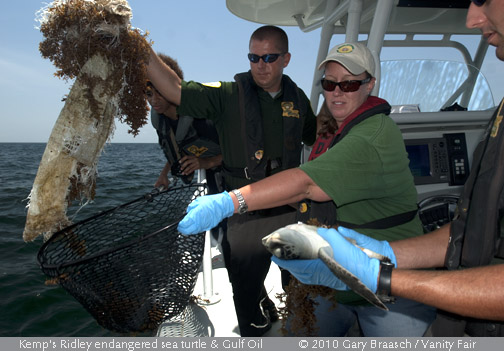
Louisiana State Dept of Wildlife & Fisheries boat crew pulls the plastic bag away from an immature Kemp's ridley sea turtle which was found in sargassum with oil on it and with flipper caught in the woven bag. Toby Meyers, an enforcement officer (l), assists biologist Mandy Tumlin; senior agent for wildiife enforcement Thomas Wolf holds the turtle. Four turtles were found this day, July 15, 2010, and transfered to the Audubon Aquatic Center for cleaning, rehab and eventual release.
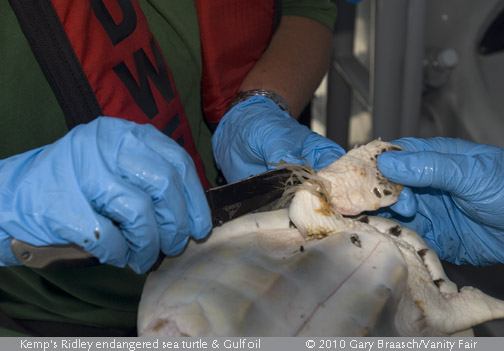
Biologist Mandy Tumlin cutting plastic bag off the young Kemp's ridley turtle right rear leg, which had been caught in an unravelling plastic bag in the sargassum. Oil was found in skin crevasses and folds of this turtle, found during a mission to locate and rescue sea turtles near the BP oil spill, about 30 miles SW of Mississippi Delta by Louisiana State Dept of Wildlife & Fisheries staff. It is one of nearly 500 sea turtles found alive in the open Gulf affected by the BP oil spill.
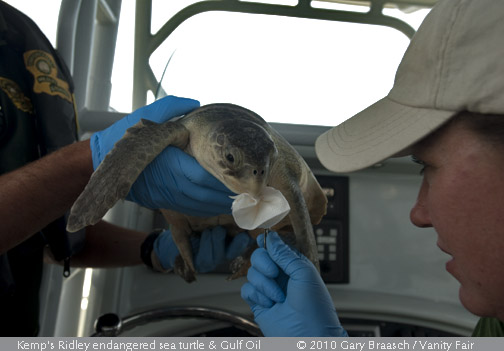
Biologist Mandy Tumlin tries to swab a young Kemp's ridley turtle for oil after it was netted in the sargassum. Oil was found in skin crevasses and folds of several turtles found during this mission to locate and rescue sea turtles near the BP oil spill, about 30 miles SW of Mississippi Delta by Louisiana State Dept of Wildlife & Fisheries staff. Turtles found near the spill were transferred to the Audubon Aquatic Center in New Orleans for cleaning, treatment, and eventual release into a cleaner Gulf
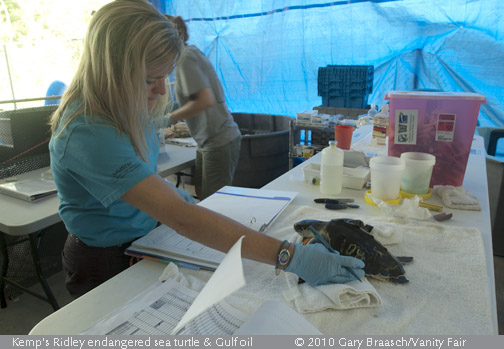
An injured Kemp's ridley juvenile sea turtle being cared for at the Audubon Aquatic Center in New Orleans, after rescue from the BP oil spill. This animal was brought in June 12 and also had broken flipper, shattered femur, fractured clavicle and a wound on shell and belly, possibly from predator attack. About 170 young turtles were being de-oiled, fed and cared for here during Gulf oil spill. Veterinarian Michele Kelly, coordinator of turtle stranding checks the turtle for healing.
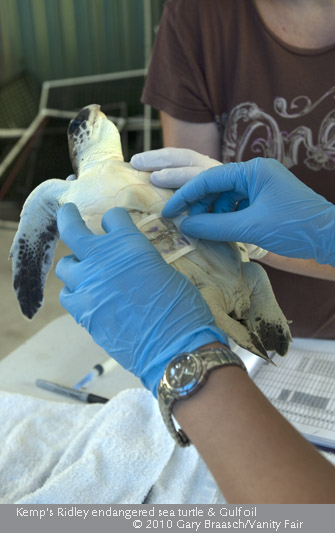
An injured Kemp's ridley juvenile sea turtle being bandaged for injuries including a broken flipper, shattered femur, fractured clavicle and a wound on shell and belly, possibly from predator attack. One of about 170 young turtles which were being de-oiled, fed and cared for at the Audubon Aquatic Center in New Orleans during Gulf oil spill.
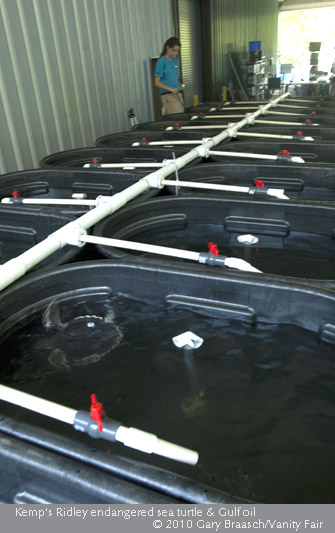
Feeding individual turtles in tanks, including many Kemp's ridley sea turtles, at the rescue and recovery center in Audubon Aquatic Center, New Orleans, where rescued turtles were de-oiled, fed and cared for during Gulf oil spill. In total, more than a thousand sea turtles were found during the oil disaster, about half were dead, mostly found near shore; but the rest were alive and mostly from open waters and sargassum sea weed areas of the Gulf. Most of the turtles were Kemp's ridley, which is the most endangered and whose juvenile habitat is centered in the oil spill area.
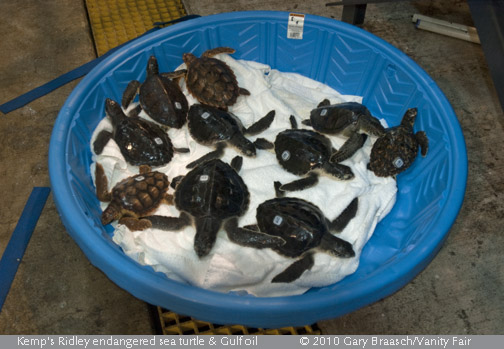
Kemp's ridley and loggerhead turtles in temporary 5 foot kiddie pool while water in their individual tanks is changed, at the turtle rescue and recovery center in Audubon Aquatic Center, New Orleans. During the BP oil spill, about 500 sea turtles were brought in to rescue centers from the crude oil-affected Gulf waters (another 580 were found dead, mostly nearer shore). The sargassum seaweed habitat of the sea turtles, including the most endangered, the Kemp's ridley, is also heavily polluted by plastic and other waste.
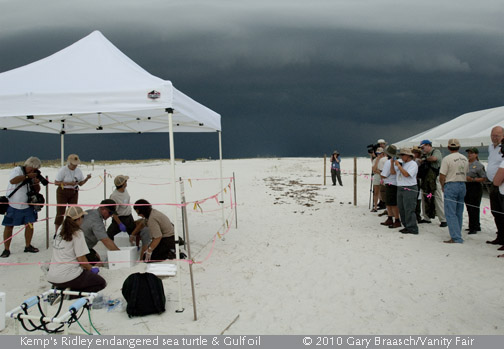
An approaching thunderstorm adds drama as members of the press witness the extraordinary excavation and transfer of 89 eggs of Kemp's Ridley sea turtle from a nest on Gulf Islands National Seashore, Florida, July 23, 2010. This is part of a project which originally expected to move about 700 nests from Mississippi to Florida to protect the hatchlings from swimming into oil-polluted water. But the Federal authorities declared the water safe for the turtles after the BP well was shut down, and only 4 Kemp ridley nests and about 270 loggerhead nests were moved.
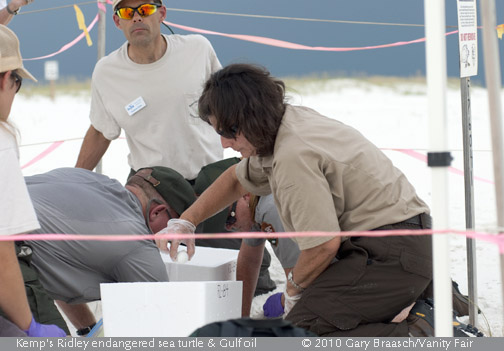
Excavation and removal of 89 eggs of Kemp's Ridley sea turtle from a nest on Gulf Islands National Seashore, Florida, July 23, 2010. Digging up and tranferering the tiny eggs is biologists Lorna Patrick (USFWS) and Mark Nicholas (NPS in hat), assisted by Monica Hardin and Andrew Diller, Escambia County FL marine biologist (sunglasses). This is part of the move of 4 other Kemps nests and about 270 loggerhead nests to be hatched on Florida's east coast in response to the Gulf Oil spill.
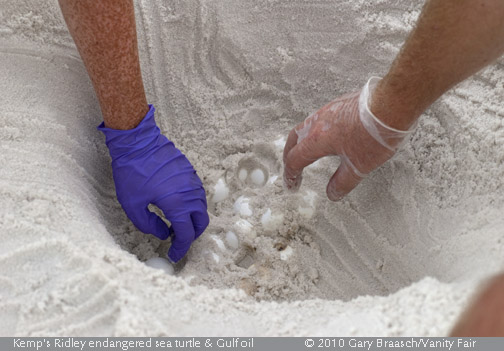
Excavation and removal of 89 eggs of Kemp's Ridley sea turtle from a nest in the white sugar sand of Gulf Islands National Seashore, Florida, July 23, 2010. This is part of the move of 4 other Kemps nests and a planned 700 loggerhead nests in response to Gulf Oil spill. In the end, only 278 nests were dug up and eggs transferred to a climate controlled warehouse at Kennedy Space Center. As of late September 14,676 hatchlings have been released into the Atlantic Ocean, far from the spill affected Gulf -- but there is no way to know how many will survive or return to the Gulf as adults.
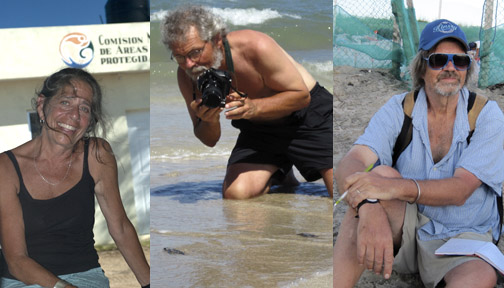
Crew for the Vanity Fair assignment: Joan Rothlein, environmental scientist; Gary Braasch, environmental photojournalist; Alex Shoulmatoff, writer and adventurer, contributing writer for Vanity Fair magazine. See his website at www.DispatchesFromTheVanishingWorld.com The Vanity Fair report by Alex is at www.vanityfair.com/culture/features/2010/09/ridley-turtles-201009
Photo Reports Intro
1. The BP Deepwater Horizon oil well gushes crude across the Gulf to beaches and marsh.
2. Crude comes ashore from Gulf Shores to Grand Isle.
3. Clean up workers and local people react to the oil.
4. Oil in the marshes greases up birds and sedges; fishing and shrimping are closed.
5. Shrimping and fishing begin to return but long term effects of oil remain.
5A. The toll on animals and birds continues; rescuers take action.
6. Indians Face Oil Spill
7. Indians Face Oil Spill 2
8. The most endangered sea turtle and the Gulf oil spill 1
9. The most endangered sea turtle and the Gulf oil spill 2
COPYRIGHT NOTICE:
Photography and text Copyright © 2005 - 2017 (and before) Gary Braasch All rights reserved. Use of photographs in any manner without permission is prohibited by US copyright law. Photography is available for license to publications and other uses. Please contact requestinformation@worldviewofglobalwarming.org. View more of Gary Braasch's photography here.


